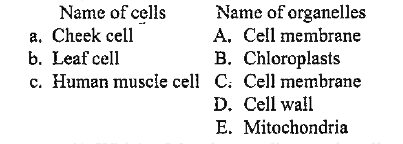Red muscles have abundant
Lactic acid and acetic acid
Glucose and haemoglobin
Relaxin and myosin
Myoglobin and cytochrome
The correct Answer is:D
Step-by-Step Solution:
1. Understanding Muscle Types: Muscles are categorized into different types based on their color and function. Red muscles, also known as slow-twitch muscles, are primarily responsible for endurance activities.
2. Identifying Key Components: Red muscles contain specific proteins and pigments that are crucial for their function. The two most notable components are myoglobin and cytochrome.
3. Role of Myoglobin: Myoglobin is a red pigment found in muscle tissues. Its primary function is to store and transport oxygen within the muscle cells. This is essential for aerobic respiration, which provides energy during prolonged, low-intensity activities.
4. Role of Cytochrome: Cytochromes are proteins found in the mitochondria of cells. They play a vital role in the electron transport chain, which is a key component of cellular respiration. The presence of cytochromes in red muscles indicates a high capacity for aerobic metabolism.
5. Conclusion: Therefore, red muscles are abundant in myoglobin and cytochrome, which facilitate efficient oxygen usage and energy production during sustained physical activities.
Final Answer: Red muscles have abundant myoglobin and cytochrome.
---
Topper's Solved these Questions
- BOOK - DINESH PUBLICATION ENGLISHCHAPTER - LOCOMOTION AND MOVEMENTEXERCISE - CHECK YOUR GRASP10videos
LOCOMOTION AND MOVEMENT
- BOOK - DINESH PUBLICATION ENGLISHCHAPTER - LOCOMOTION AND MOVEMENTEXERCISE - CHECK YOUR GRASP10videos
LOCOMOTION AND MOVEMENT
- BOOK - DINESH PUBLICATION ENGLISHCHAPTER - LEAFEXERCISE - CYG10videos
LEAF
- BOOK - DINESH PUBLICATION ENGLISHCHAPTER - MAMMALIA [MAMMA - BREAST]EXERCISE - Brain Teasers - I100videos
MAMMALIA [MAMMA - BREAST]
Similar Questions
Go through the following statements
During muscle contraction, the width of A-band remains constant while I-band shortens.
During muscle contraction, the Ca2+ released from the SR bind to the troponin component of thin filament
The process of muscle contraction is faster in smooth muscle as they have a well developed sarcoplasmic reticulum.
The red muscle fibres have abundant mitochondria, low glycogen and poorly formed sarcoplasmic reticulum.View SolutionFast twitch muscle fibres have abundant
View Solution
Knowledge Check
- Question 1 - Select One
Assertion: Red muscles depend on anaerobic process for energy.
Reason: Red muscles have few number of mitrochondira in themAIf both assertion and reason are ture and reason is the corect explanation of assertionBIf both assertion and reason are ture but reson is not the correct explanation of assertionCIf assertion is true reason is falseDIf both assertion and reason are false - Question 2 - Select One
Cells which are secretory in function have abundant
AlysosomesBendoplasmic reticulumCdictyosomesDosteosomes.
[A]: Sieve tube members have abundant cytoplasm but there is no nucleus.
[R]: The nucleus disintegrates during their developmentView SolutionWhat is common between the muscle fibers of extensor of human back and those of flight muscles of the birds which remain in flight for long periods of time ?
a. They are thinner , red colored
b, they are thicker and light colored .
c. they have abundant mitochondria .
d. they have well developed sarcoplasmic reticulum
e. they show rate of contractions for longer periods
f, They show fast strenuous activity
g. They do not get fatigued early .
h. They get fatigued quickly .View SolutionBoth nucellus and endosperm have abundant reserve food materials. How is their food reservoir utilised in angiosperms ?
View SolutionWhich law of evolution states that "Warmblooded" mammals of hot and humid areas have abundant melanin pigment
View SolutionThe following list contains three cells and four cell organelles :

Which of the above cell would have abundance of organelle E?View SolutionRed muscle are rich in
View Solution

